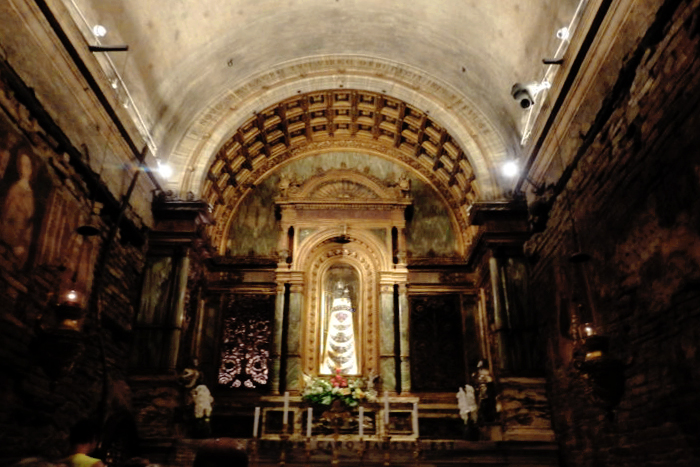
The Church of the Intercession located on the Nerl River is the very first Intercession church known to the world. It remained such for 200 years following its foundation which still attracts many researchers and pilgrims. Like a white sail, this temple has been drifting serenely over the endless waves of centuries. At the same time, its history still gives rise to many questions and controversial assumptions.
The church is known to have been erected during the reign of the Grand prince St Andrey Bogolyubsky, probably, by European architects. Like all the pre-Mongol white-stone temples of North-Eastern Russia, Pokrovsky* on the Nerl was built in the Romanesque style, dominating in Europe at that time. The proportions of the temple make up the “golden ratio”.
According to the chronicle, the temple was erected within just one year, a surprisingly short time frame for that age. The exact date of its construction, however, has not been determined. The researchers adhere to the version according to which the foundation dates back to 1158. The chronicle says that in 1157 Prince Andrey came to Vladimir lands and commissioned two churches in honor of the Most Holy Theotokos: the Nativity of the Theotokos church on the Klyazma River and the Intercession church on the Nerl. Prince Andrey’s hagiography describes that in 1155 he was blessed with a vision of the Most Holy Theotokos. The Mother of God ordered the prince to build a temple and a holy monastery. The city that grew around the Nativity of the Theotokos monastery was named Bogolyubov. The second temple was the Intercession church on the Nerl. Its location is only a verst** from Bogolyubov.
Andrei Bogolyubsky was zealous about venerating the Theotokos and erected almost all churches in Her honor. According to historical data, the temples dedicated to the Feast of the Intercession simply did not exist before the foundation of the church on the Nerl. Only from the 14th century they began to be erected in large numbers across Russia.
It is remarkable that this white-stone church was built on an artificially created hill. That hill prevents the water from coming to the temple’s front doorstep in spring, when the rivers Klyazma and Nerl spill over the entire meadow around.

Researchers have different versions of the reasons and the purpose of erecting the Intercession Church in that place. Notwithstanding, over time, the temple became a part of the Monastery. The Monastery has been known since the 16th century. Descriptions of the late period of St Andrey’s life mention him founding the Monastery at the Intercession Church.
During the reign of Empress Catherine II, the monastery was abolished along with many others. Along with that, the temple was to be dismantled “due to dilapidation”, but the customer could not agree on a price with the contractor, and it miraculously survived to our time, virtually retaining its original appearance. That said, the white-stone open galleries, presumably once surrounding the church on three sides, and the large staircase leading to the river, have not survived. We can imagine the temple at the time of its splendor only by its scientific reconstruction.


The external decor of the Intercession Church’s walls designed as beautiful white stone carving has been well preserved. That is rare among such ancient monuments.

On three facades at the top there are images of King David – a symbol of a wise ruler. The young king is depicted sitting on the throne, holding Psalthyrion in his left hand and his right hand raised in a blessing gesture. The king is surrounded by lions and doves. The pigeons personify the Holy Spirit, while the lions, being a familiar decor of Romanesque architecture, in the Vladimir-Suzdal lands became associated with the local princes. The lion is still present on Vladimir city’s coat of arms.

A row of female facial images (an element no less popular in Romanesque architecture) is also encircling the three walls of the temple. The versatile rounded-shape images look refined. The most inspiring of them is located in the center of the western wall. It is often compared to the iconic images of the Mother of God.

The bas-relief of a griffin with a deer is interpreted here as an image of Christ the Savior carrying a righteous Christian soul.

Other images on church walls are difficult to justify. Some of them have completely deteriorated or become difficult to distinguish.



The interior decoration of the Intercession Church must have once amazed with its splendor. The image of Christ depicted in the dome was surrounded by archangels and seraphims. The walls were decorated with many vibrant murals, and the floor was embellished with colored maiolica. However, we will not see any of that here today. The entrance to the choir gallery also did not survive. In “royal” churches it was usually occupied by rulers with their family members, if they were present during the divine services. That was also where they received Communion.


And yet, by God’s grace, the temple on the Nerl continues to stand. Perhaps the Lord preserves this church precisely for us, in the words of the Russian artist I. Grabar, “to gain eternity before its eternal beauty”.

*Pokrov (Russian) or Pokrova (Ukrainian), name for the Intercession of the Theotokos, one of the Russian and Ukrainian Orthodox feasts
**A verst (Russian: верста, versta) is an obsolete Russian unit of length defined as 500 sazhen. This makes a verst equal to 1.0668 kilometres (0.6629 miles; 3,500 feet).




